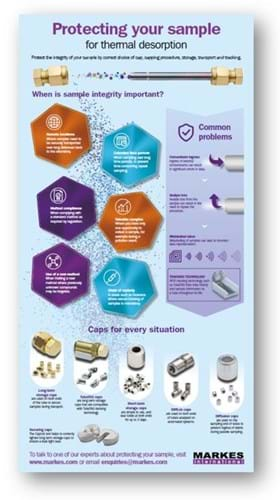
Sorbent tube caps and their role in protecting thermal desorption samples
21 January, 2019
Ensuring sample integrity
Of the many things you need to stay on top of as a thermal desorption analyst, ensuring sample integrity is one issue that doesn’t always come to mind.
But it’s worth looking afresh at topics like this, dealing with issues that we almost take for granted. In this case, what exactly are we securing our samples against? What are the options? And most importantly, are we going about things the best way?
In this blog post, I’ll tackle the topic of sample security for TD, to give you a fresh perspective on this important aspect of thermal desorption.
When is protecting your sample most important?
Of course, all samples are valuable. And provided you realise the need in good time, going back to repeat a procedure may still be possible. For example, if you’re doing dynamic headspace on a batch of materials sent to your lab, re-acquiring the sample is (arguably) not too much of an inconvenience.
However, in other situations sample integrity becomes paramount:
- Sampling in remote locations: Getting samples from a remote field station to the lab represents a major investment of time and money. See examples of our tubes used in the Amazon rainforest and Arctic heathland.
- Sampling over extended time periods: Passive sampling is sometimes carried over periods of several weeks (as for example in refinery fenceline air monitoring in accordance with US EPA Method 325). Although it’s commonplace to take duplicate samples, when this much time is devoted to sampling it’s wise to ensure that no risks are taken with sample integrity.
- Following a standard method: Confidence in sample integrity underpins all work carried out in accordance with standard methods, especially where these relate to health requirements such as workplace exposure, environmental monitoring, or emissions from building products. In many of these being able to demonstrate ‘chain of custody’ is a requirement of the method.
- Unique sampling opportunities: In some applications such as medical diagnostics or monitoring of pollution events, a collected sample represents a unique event that cannot be replicated.
- Deployment of a new method: If you don’t know what compounds you’re expecting, then a contaminated sample might give you an incorrect impression of what you’ve got.
The risks to sample integrity
There are two main factors that can affect the physical integrity of a sample captured on TD tubes:
- Ingress of external contaminants: Whether from air in the field or the lab, or volatiles from packaging, there’s no point in carefully taking your sample only to unwittingly expose it to airborne contaminants later on. Such contamination at best causes your results to be unrepresentative, and at worst can result in false-positives.
- Analyte loss: All analytes are in equilibrium with the sorbents contained in a TD tube. Although for many analyte–sorbent combinations the equilibrium is strongly tilted in favour of the analytes remaining bound to the sorbent (until analysis of course), lighter components can be prone to desorbing, especially at high temperatures. This causes lower recovery and perhaps failure to detect key analytes.
Minimising your risks
Use of appropriate caps on your TD tube is the best way of eliminating risks to sample integrity, along with other precautions like avoiding contaminated atmospheres, and using appropriate tube storage containers (for more details on these, see our Application Note on storage and transport of sorbent tubes).

So turning to the caps themselves, it’s important to pick the right type. There are a number of considerations here:
1. Method: Caps are required in order to comply with standard methods such as US EPA Method TO-17, ASTM D6196 and EN ISO 16017.
2. Sampling approach: The sampling method affects choice of caps – for example, for passive sampling, diffusion caps must be used.
3. Storage: Length of storage should be considered. For long-term storage, our two-piece brass caps with PTFE ferrules have been validated for periods of up to 27 months.
4. Automation: If using an automated Markes TD system, then a pair of diffusion-limiting DiffLok caps optimise productivity by avoiding the need to cap and uncap the tube.
5. Instrument brand: Industry-standard caps are required when using Markes, PerkinElmer or Shimadzu instruments.
Mislabelled samples
In addition to risks to the physical integrity of a sample, there is also the risk of tubes being mislabelled. This is a natural hazard of manual record-keeping, with the obvious result that data is assigned to the wrong sample.
The answer is robust tracking of samples and associated information, and this can be achieved in two ways:
- Clear labelling of tubes with a unique number: Having this number represented in barcode form assists automated identification.
- Radio-frequency ID tags: These enable tube history and sample information to accompany a tube throughout its lifetime. They’re therefore good for reducing transcription errors, and are better for tracking tubes during field monitoring projects.
Markes' TubeTAG system offers the ultimate in sample tracking for TD tubes – take a look at the product page if you’d like to know more.
So in conclusion, it’s worth being aware of the various ways of ensuring sample integrity, and making sure you’re using the right tool for the job.





